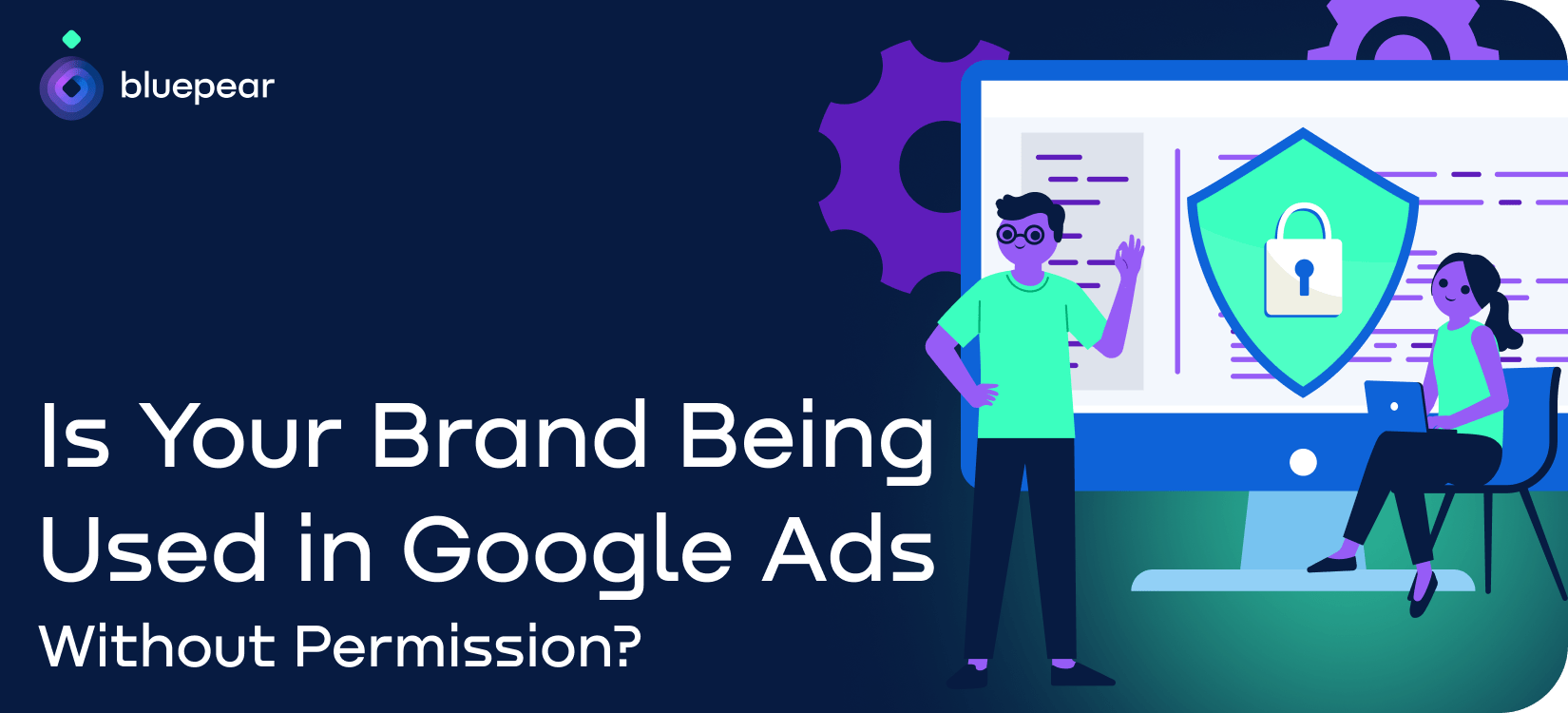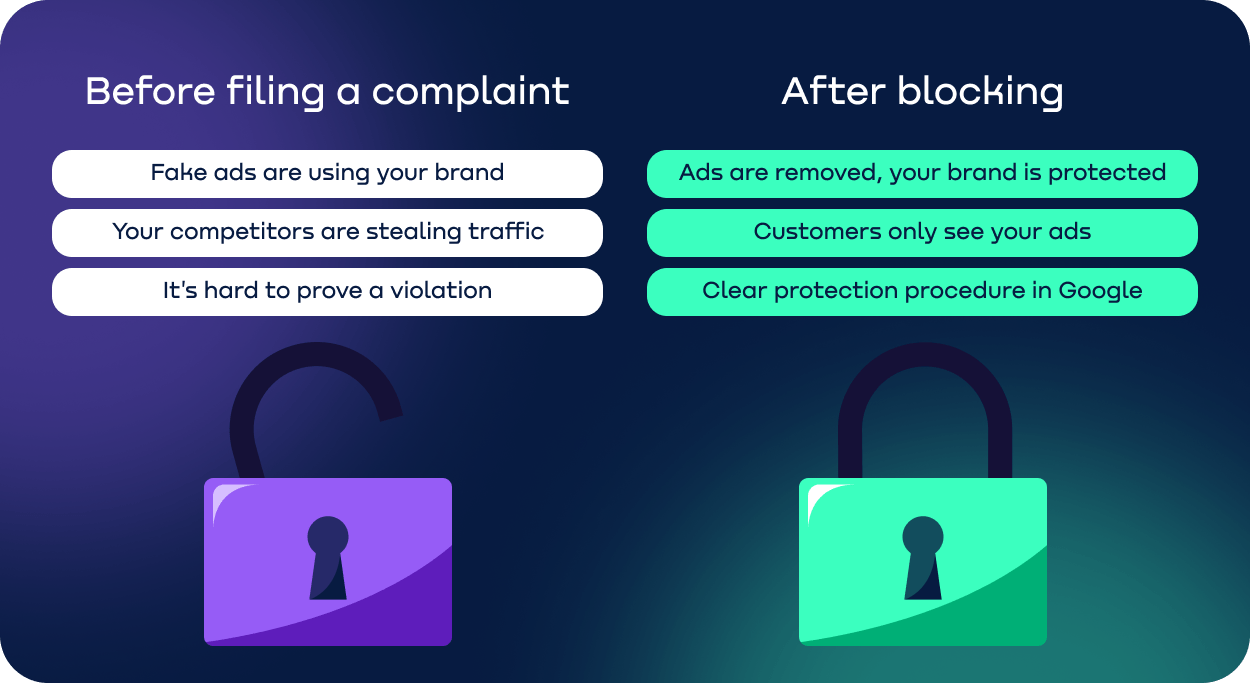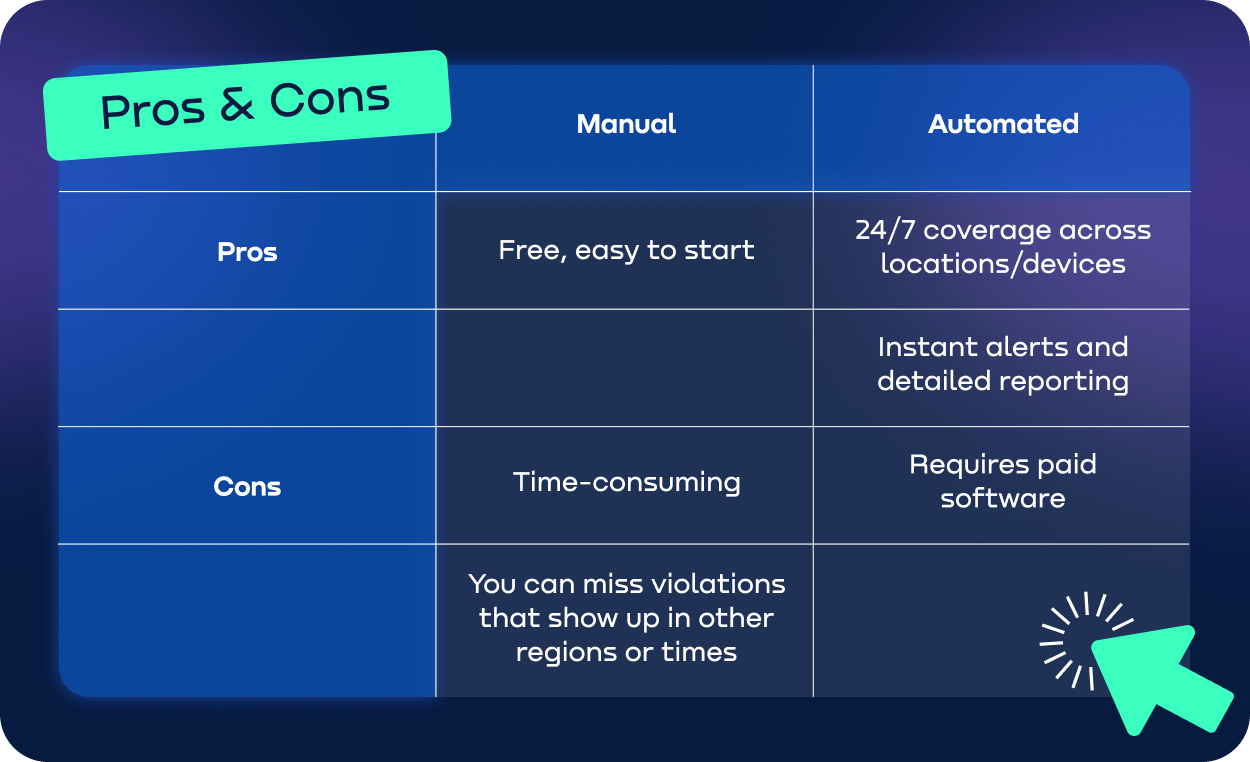
Contents
Imagine: you work hard on developing your brand. Your team invests money, efforts, and time to make your brand’s name well known among the potential clients. So, when the time comes and you get a solid base of loyal customers, you kindly hand them over to your competitors like a gift. What a generous gesture!
Sounds weird, doesn’t it? But that’s what actually happens if you don’t monitor your brand compliance online.
When people search for your brand on Google, they usually expect to find your official site, social media profiles, or trusted pages related to your business. But competitor ads might pop up right above or alongside your listings. Why? Because rivals can bid on your brand name as a keyword in their Google Ads. So even though someone is specifically looking for you, Google may still display competitor ads in the results. Fortunately, you can successfully combat Google trademark infringement with the right tools and techniques. You just need to spot it in time and address it as quickly as possible. Both become possible with the use of automated monitoring. In the sections below, we’ll explore how to ensure brand compliance and safety of your trademark in Google Ads using the right tools and strategies.
What Is Google Trademark Infringement?
Trademark infringement on Google occurs when a third party uses your brand name or other legally protected brand identifiers without authorization. In Google Ads, trademark abuse can appear in different forms. Most often, Google trademark infringement shows up in two main areas:
Keywords. Competitors may use your brand name as a search keyword to promote their own products. As a result, their ads are triggered when someone looks for your brand — even if their business has nothing to do with yours. People searching for your company might click on these ads by mistake, especially if they show up first in the results.
Example: Your brand is GreenCup Coffee. A competitor bids on the keyword “GreenCup Coffee.” When someone types that into Google, the top ad says: “Better Than GreenCup – Try Our Organic Coffee Today!” Even though the competitor doesn’t pretend to be your brand, they might steal the clicks.
Ad copy. This is when your trademark is used directly in the text of a competitor’s ad. Using a trademark in the actual ad copy can confuse users. It may make them think the ad is from the brand owner.
Example: Your brand is GreenCup Coffee. A competitor runs an ad that says: "GreenCup Coffee On Sale – Buy Now!" But they don’t sell your products or have your permission. To be clear, it’s not just competitors who may use your trademark in Google Ads. Some affiliates also bid on branded keywords or include your brand name in their ad copy. They apply this fraudulent technique to attract cheap leads that are likely to convert into real customers. The problem is, you end up overpaying affiliate commissions for customers you would’ve acquired anyway.
Learn more about trademark infringement and how to spot it in time with all the needed evidence.
Google Trademark Infringement Policy: the Main Rules
Google trademark policy protects brands from unauthorized use of their branded elements. On the other hand, Google trademark policy is designed to find a middle ground between the rights of trademark holders, the needs of advertisers, and the experience of users. Although some uses of trademarks are allowed, Google has clear rules to prevent abuse or misleading practices.
Let’s see what’s allowed and what’s prohibited in terms of Google trademark policy:
Keywords. Third-party marketers are allowed to use branded keywords even if they don’t own the trademark. Google usually doesn’t sanction advertisers for this marketing tactic. That’s why you might have seen Adidas ads while searching for Nike. The only way to protect your ads in this case is to increase the bid for keyword placement.
Ad text. Including a trademark you don’t own in your ad text is typically prohibited, particularly in situations where:
• The advertiser is a direct competitor of the trademark holder.
• The ad could mislead users into believing there’s an official partnership or endorsement by the trademark owner.
These types of uses may result in ad disapproval or removal by Google. Still, there are exceptions where use of a trademark in Google ads is permitted. This includes:
• The website clearly focuses on selling or helping users purchase the products or services associated with the trademark.
• The page offers factual, educational, or comparative information about the branded goods or services.
• The trademark is used in a descriptive, non-branded way — for example, using the word “apple” to describe the fruit, not the company.
Google trademark policy applies universally; however, certain brands may receive heightened attention due to their prominence or frequent misuse. While no brands are explicitly listed as having special protection, trademark owners can submit complaints if they believe their trademarks are being misused
In March 2024, Google revised its Misrepresentation policy to expand protections against deceptive advertising. The updated rules specifically ban ads that trick users into sharing money or personal data by falsely suggesting a connection with a well-known brand, public figure, or organization. This change took effect globally (excluding France) in March, with enforcement in France starting in April 2024.
How Does Brand Compliance Monitoring Work?
Brand compliance refers to ensuring that your brand is used correctly and consistently across all channels — especially in advertising. Brand compliance monitoring includes tracking how your brand name, logo, slogans, and other trademarks are represented by affiliates, partners, resellers, or even competitors. In digital advertising, brand compliance is particularly important in platforms like Google Ads, where third parties might misuse your brand for clicks, misleading promotions, or unfair competition. Brand compliance monitoring is essential if you want to:
• Address violations of brand compliance quickly.
• Avoid wasting your marketing budgets.
• Keep your customers loyal and confident in your brand.
• Discourage dishonest marketers from abusing your trademark in the future.
You can start with manual monitoring. This kind of manual check gives you a quick snapshot — but it has limits. You won’t see all locations, all times of day, or all devices. That’s why manual monitoring isn’t a long-term solution.
Brand monitoring software helps to catch violations in real time from all the possible GEOs, devices, and browsers.

How to File a Complaint About Google AdWords Trademark Infringement?
If you’ve noticed that affiliates, competitors, or some fraudsters use your brand name without permission, it’s high time to take real action.
Here’s our step-by-step instruction on how to file a complaint about Google AdWords trademark infringement:
1. Open Google’s trademark complaint form. You can find it here on Google’s official site.
2. Choose the right option. Select Google Ads (formerly known as AdWords) as the platform where the trademark is being misused.
3. Fill out the complaint form. You’ll need to enter some personal data, proof of trademark ownership, and specific evidence of the Google AdWords trademark infringement.
4. Submit the complaint form. Once submitted, Google will send you a confirmation and begin reviewing your complaint.
So, this is the process of filing a complaint about Google AdWords trademark infringement.
Google typically processes trademark complaints within several business days, though more complicated cases can take up to two weeks. Once the complaint is validated, the infringing ads may be taken down or modified.

Brand Monitoring Software for Protection in Google Ads
To protect your brand in search advertising—particularly on platforms like Google Ads—using brand monitoring software is highly effective. Such tools allow you to monitor how your brand name appears in paid ads, whether it's used by affiliates, resellers, or competing advertisers. Here’s how brand monitoring software works:
• You set keywords. Add your brand name and related terms to monitor.
• The system scans ads. It checks Google search results 24/7 across regions and devices.
• Brand compliance software detects violations. The tool finds ads using your brand name without permission.
• You get alerts. The brand monitoring software notifies you when misuse is found.
• You get reports. It creates proof with screenshots and links for action, so that you can use the data to file complaints or contact violators.
Let’s compare manual monitoring and automated brand compliance monitoring:
If you're a small brand just starting out, manual checks might work for now. But as your brand grows — and more people start misusing your name — automation becomes essential. Brand monitoring software helps you stay in control, cut down on affiliate abuse, and protect your reputation without spending hours doing it all yourself.
Trademark Infringement: a Real Case Study and Best Practices
In April 2024, the footwear brand Dr. Martens initiated legal action against the online marketplace Temu, alleging unauthorized use of its trademarks. The lawsuit claimed that Temu purchased Google Ads containing branded search terms such as "Dr. Martens" and "Airwair" to promote lookalike footwear.
As a consequence, Temu’s ads were displayed above the official Dr. Martens links in search results, which could have misled consumers and diverted traffic from the genuine brand.
As of today, the legal process is still underway, and no final decision has been made public. This case highlights the importance for brands to actively monitor and protect their trademarks from Google AdWords fraud.

How to Protect Your Brand from Google Trademark Infringement?
Protecting your trademark online is a permanent process rather than a one-time effort. Yet, the risk of violations can be reduced if you consistently work on it using modern techniques and best practices. Here’s a checklist for marketers and brand owners who want to protect their trademark:
✅Register your trademarks in all key regions where your business operates.
✅Monitor your branded search using both manual checks and automated tools.
✅Set up brand monitoring software for 24/7 coverage.
✅Set clear rules in brand compliance policy about trademark usage.
✅Act quickly — file trademark complaints as you detect a violation.
FAQ
What is Google trademark infringement in advertising?
It’s when another advertiser uses your brand name in keywords or ad text without permission. This can mislead users, divert branded traffic, or inflate affiliate commissions you shouldn’t be paying.
Why do competitors use branded keywords in Google Ads?
Google allows bidding on branded terms, even without authorization. Competitors use this to capture users searching for your brand, hoping to redirect them to their own offers.
When is using a trademark in Google ad copy prohibited?
If it misleads users, suggests a partnership that doesn’t exist, or is used by a direct competitor without permission. These cases often qualify for removal via a Google Ads trademark complaint.
How does a Google Ads trademark complaint work?
You submit proof of ownership, include examples of misuse, and file the form on Google’s official page. After review, Google may disapprove or modify the infringing ads, typically within several business days.
What makes brand compliance monitoring essential?
Manual checks miss violations that appear only in certain GEOs, at night, or on specific devices. Continuous monitoring ensures you catch misuse early, prevent wasted spend, and maintain customer trust.
How can Bluepear support trademark enforcement in Google Ads?
Bluepear scans SERPs across devices, GEOs, and dayparts, detects unauthorized trademark use, breaks through cloaking, and compiles screenshots and URLs into evidence-ready reports you can use in Google Ads trademark complaints.
What best practices help protect your brand from misuse in Google Ads?
Register trademarks in all key markets, monitor branded search regularly, set clear compliance rules for affiliates, and act quickly when violations appear to prevent long-term impact.

